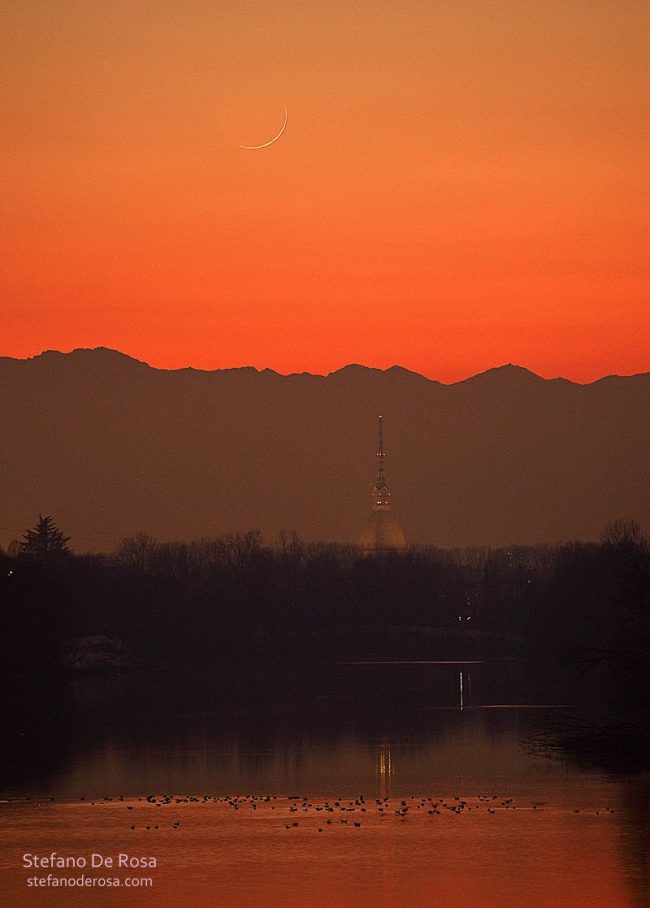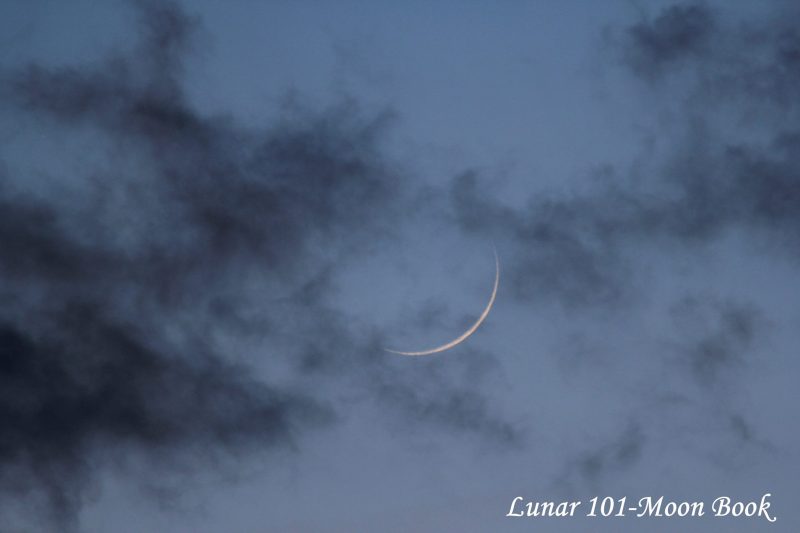

Young moon of January 18, 2018 from Aimilianos Gkekas at Meteora near Kalambaka, Greece.
The moon has returned to the evening sky now. You’re likely to see it in the coming evenings. Astronomers call it a young moon – a waxing crescent – when the moon appears in the west shortly after sunset. The moon is now waxing toward the second full moon of this month, what in modern folklore has come to be called a Blue Moon. This full moon will also be at its closest to Earth for this month, a supermoon. And it’ll undergo an eclipse visible from North America. A super Blue Moon eclipse!
The super Blue Moon eclipse happens before sunrise on January 31 for North America and Hawaii. It happens after sunset on January 31 for the Middle East, Asia, Indonesia, Australia and New Zealand.
Read more: Super Blue Moon eclipse coming up January 31
Where will you see the moon this week? It’s in the west shortly after sunset.
Some people think a moon visible in the west after sunset is a rising moon. But it’s not; it’s a setting moon. All objects in our sky rise in the east and set in the west, due to Earth’s spin under the sky. When you see a waxing crescent, you know the Earth, moon and sun are located nearly on a line in space. If they were more precisely on a line, as they are at new moon, we wouldn’t see the moon. The moon would travel across the sky during the day, lost in the sun’s glare.
As it is, the waxing crescent moon is just off the Earth-sun line and so appears in the west, just above the sunset.

Stefano De Rosa caught a super-thin waxing crescent moon on December 19, over the Alps and the Mole Antonelliana.
Note also that a crescent moon has nothing to do with Earth’s shadow on the moon. The only time Earth’s shadow can fall on the moon is at full moon, during a lunar eclipse. There is a shadow on a crescent moon, but it’s the moon’s own shadow. Night on the moon happens on the part of the moon submerged in the moon’s own shadow. Likewise, night on Earth happens on the part of Earth submerged in Earth’s own shadow.
Because the waxing crescent moon is nearly on a line with the Earth and sun, its illuminated hemisphere – or day side – is facing mostly away from us. We see only a slender fraction of the day side: a crescent moon. Each evening, because the moon is moving eastward in orbit around Earth, the moon appears farther from the sunset glare. It is moving farther from the Earth-sun line in space. Each evening, as the moon’s orbital motion carries it away from the Earth-sun line, we see more of the moon’s day side. Thus the crescent in the west after sunset appears to wax, or grow fatter each evening.
The pale glow on the darkened portion (night side) of a crescent moon is called earthshine. Is caused by light reflected from Earth’s day side onto the moon. After all, when you see a crescent moon in Earth’s sky, any moon people looking back at our world would see a nearly full Earth. Read more: What is earthshine?

Waxing crescent moon – December 19, 2017 – by Steven A. Sweet of Lunar 101-Moon Book.
As the moon orbits Earth, it changes phase in an orderly way. Follow these links to understand the various phases of the moon.
Four keys to understanding moon phases
Where’s the moon? Waxing crescent
Where’s the moon? First quarter
Where’s the moon? Waxing gibbous
What’s special about a full moon?
Where’s the moon? Waning gibbous
Where’s the moon? Last quarter
Where’s the moon? Waning crescent
Where’s the moon? New phase
Check out EarthSky’s guide to the bright planets.
from EarthSky http://ift.tt/1trITpz


Young moon of January 18, 2018 from Aimilianos Gkekas at Meteora near Kalambaka, Greece.
The moon has returned to the evening sky now. You’re likely to see it in the coming evenings. Astronomers call it a young moon – a waxing crescent – when the moon appears in the west shortly after sunset. The moon is now waxing toward the second full moon of this month, what in modern folklore has come to be called a Blue Moon. This full moon will also be at its closest to Earth for this month, a supermoon. And it’ll undergo an eclipse visible from North America. A super Blue Moon eclipse!
The super Blue Moon eclipse happens before sunrise on January 31 for North America and Hawaii. It happens after sunset on January 31 for the Middle East, Asia, Indonesia, Australia and New Zealand.
Read more: Super Blue Moon eclipse coming up January 31
Where will you see the moon this week? It’s in the west shortly after sunset.
Some people think a moon visible in the west after sunset is a rising moon. But it’s not; it’s a setting moon. All objects in our sky rise in the east and set in the west, due to Earth’s spin under the sky. When you see a waxing crescent, you know the Earth, moon and sun are located nearly on a line in space. If they were more precisely on a line, as they are at new moon, we wouldn’t see the moon. The moon would travel across the sky during the day, lost in the sun’s glare.
As it is, the waxing crescent moon is just off the Earth-sun line and so appears in the west, just above the sunset.

Stefano De Rosa caught a super-thin waxing crescent moon on December 19, over the Alps and the Mole Antonelliana.
Note also that a crescent moon has nothing to do with Earth’s shadow on the moon. The only time Earth’s shadow can fall on the moon is at full moon, during a lunar eclipse. There is a shadow on a crescent moon, but it’s the moon’s own shadow. Night on the moon happens on the part of the moon submerged in the moon’s own shadow. Likewise, night on Earth happens on the part of Earth submerged in Earth’s own shadow.
Because the waxing crescent moon is nearly on a line with the Earth and sun, its illuminated hemisphere – or day side – is facing mostly away from us. We see only a slender fraction of the day side: a crescent moon. Each evening, because the moon is moving eastward in orbit around Earth, the moon appears farther from the sunset glare. It is moving farther from the Earth-sun line in space. Each evening, as the moon’s orbital motion carries it away from the Earth-sun line, we see more of the moon’s day side. Thus the crescent in the west after sunset appears to wax, or grow fatter each evening.
The pale glow on the darkened portion (night side) of a crescent moon is called earthshine. Is caused by light reflected from Earth’s day side onto the moon. After all, when you see a crescent moon in Earth’s sky, any moon people looking back at our world would see a nearly full Earth. Read more: What is earthshine?

Waxing crescent moon – December 19, 2017 – by Steven A. Sweet of Lunar 101-Moon Book.
As the moon orbits Earth, it changes phase in an orderly way. Follow these links to understand the various phases of the moon.
Four keys to understanding moon phases
Where’s the moon? Waxing crescent
Where’s the moon? First quarter
Where’s the moon? Waxing gibbous
What’s special about a full moon?
Where’s the moon? Waning gibbous
Where’s the moon? Last quarter
Where’s the moon? Waning crescent
Where’s the moon? New phase
Check out EarthSky’s guide to the bright planets.
from EarthSky http://ift.tt/1trITpz

Aucun commentaire:
Enregistrer un commentaire